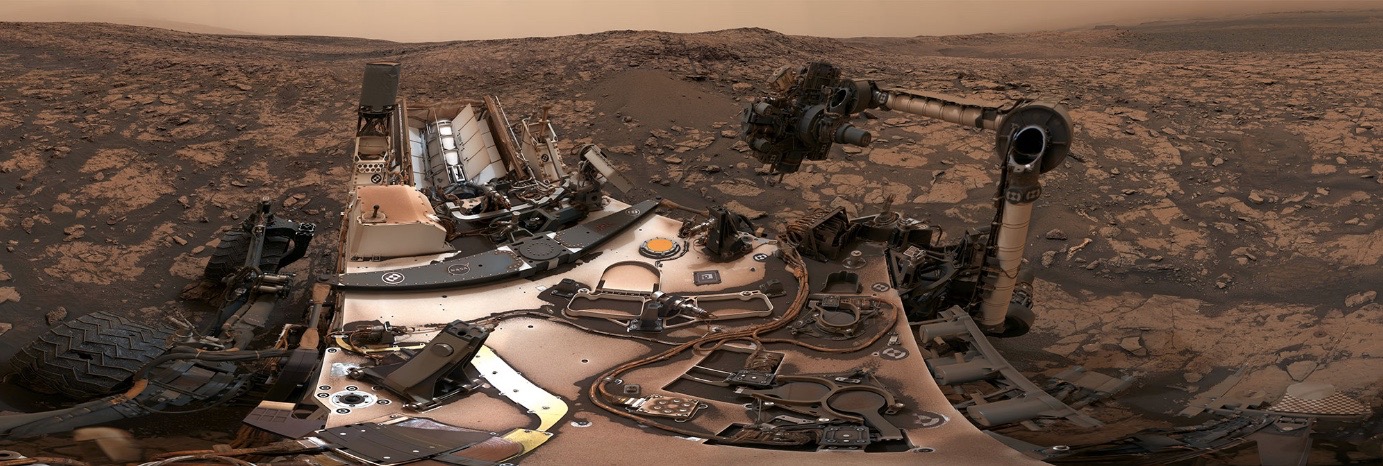Curiosity Rover Snaps Gorgeous Panoramic Selfie on Mars Mountain (Photo)

NASA's Mars rover Curiosity has snapped a view of itself and its exotic, colorful Red Planet surroundings in a single glorious, 360-degree shot.
Curiosity took the panoramic photo on Aug. 9, shortly after bagging up its latest drilled-rock sample. The interactive image, which NASA released yesterday (Sept. 6), shows the diverse terrain of Vera Rubin Ridge, which the car-size rover has been exploring for about a year. Dust darkens the sky above Curiosity and peppers the six-wheeled robot's deck.
There's been a lot of dirt in the Martian atmosphere since late May, when a dust storm kicked up near Curiosity's older, smaller cousin, Opportunity. This flare-up intensified rapidly, blocking sunlight to the solar-powered Opportunity, which went silent on June 10. By June 20, the storm had grown into a planet-girding maelstrom. [Mars Dust Storm 2018: What It Means for Opportunity Rover]
The dust storm ceased intensifying in late July, and it continues to die down. Opportunity still hasn't made a peep, but NASA officials have expressed optimism that they could end up hearing from the venerable rover before too much longer.
Curiosity is nuclear-powered, so the dust storm hasn't affected its activities too much. But the 1-ton rover has been working through some other issues lately. For example, Curiosity's previous two drilling attempts — the ones before the early-August breakthrough — produced no usable samples.
These failures don't reflect on the effectiveness of Curiosity's new, workaround drilling technique, which the mission team adopted after a key drill component failed in late 2016. The new method works quite well, Curiosity team members said; the rocks the rover tried to drill were just superhard.
The hardness may be the result of long-ago groundwater flows, which spread a sort of cement throughout some of the sediments that came to comprise Vera Rubin Ridge, Curiosity principal investigator Ashwin Vasavada, of NASA's Jet Propulsion Laboratory in Pasadena, California, said in a NASA statement.
Get the Space.com Newsletter
Breaking space news, the latest updates on rocket launches, skywatching events and more!
Vera Rubin Ridge sits on the flanks of Mount Sharp, the 3.4-mile-high (5.5 kilometers) mountain that rises from the center of the 96-mile-wide (154 km) Gale Crater. The foothills of Mount Sharp have been Curiosity's prime science destination since before the rover launched; mission team members were always keen to have the rover climb through those foothills, reading a history of Mars' changing environmental conditions in the rocks as it goes.
The mission team plans to conduct two more drilling operations on Vera Rubin Ridge this month. If all goes according to plan, Curiosity will climb off the ridge in October, headed for clay- and sulfate-bearing deposits higher up on Mount Sharp, NASA officials said.
Follow Mike Wall on Twitter @michaeldwall and Google+. Follow us @Spacedotcom, Facebook orGoogle+. Originally published on Space.com.
Join our Space Forums to keep talking space on the latest missions, night sky and more! And if you have a news tip, correction or comment, let us know at: community@space.com.

Michael Wall is a Senior Space Writer with Space.com and joined the team in 2010. He primarily covers exoplanets, spaceflight and military space, but has been known to dabble in the space art beat. His book about the search for alien life, "Out There," was published on Nov. 13, 2018. Before becoming a science writer, Michael worked as a herpetologist and wildlife biologist. He has a Ph.D. in evolutionary biology from the University of Sydney, Australia, a bachelor's degree from the University of Arizona, and a graduate certificate in science writing from the University of California, Santa Cruz. To find out what his latest project is, you can follow Michael on Twitter.









